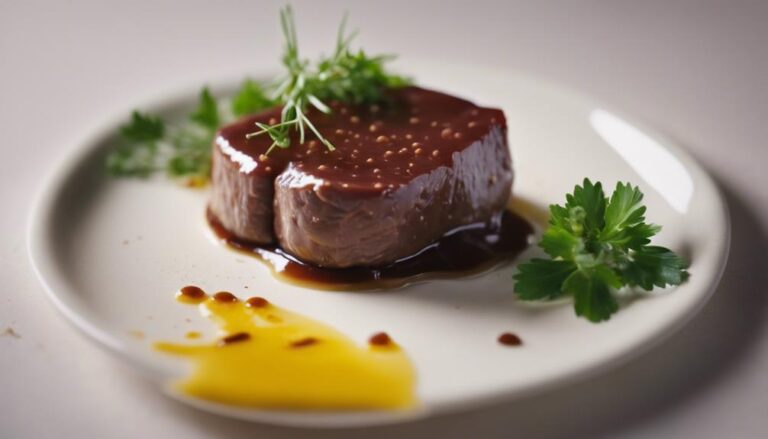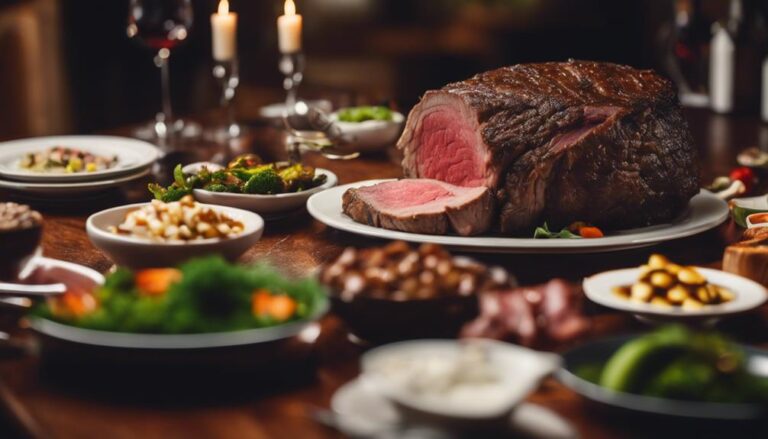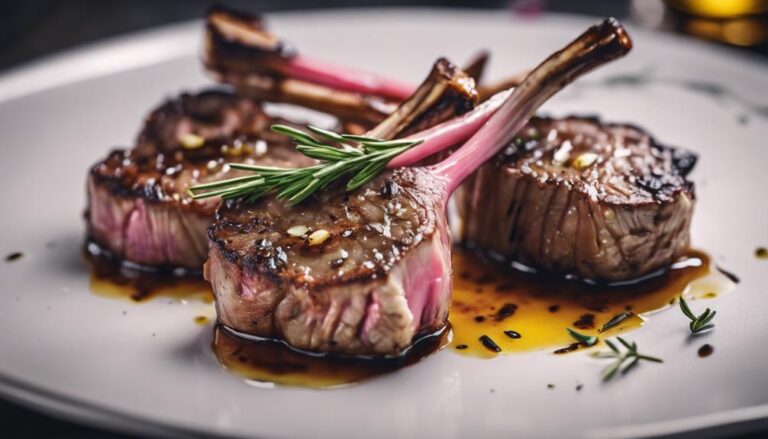Sous Vide Beef Bone Broth: A Carnivore Essential
When it comes to your carnivorous needs, sous vide beef bone broth stands out as an essential powerhouse. Packed with nutrients and collagen, it supports gut health, joint function, and skin elasticity efficiently. This protein-rich broth not only offers deep flavors but also a smooth, velvety texture that adds a luxurious touch to your culinary creations. Elevate your dishes and well-being with this delicious addition.
What You Will Learn Here
- Sous vide beef bone broth maximizes nutrient extraction for optimal health benefits.
- The sous vide method ensures a rich, collagen-packed broth essential for joint health.
- Velvety texture and intense flavors make sous vide beef bone broth a culinary necessity.
- Carnivores benefit from the protein-rich, nutrient-dense profile of sous vide beef bone broth.
- Elevate dishes with sous vide beef bone broth, delivering a luxurious and healthful addition.
Broth's Ancient Origins
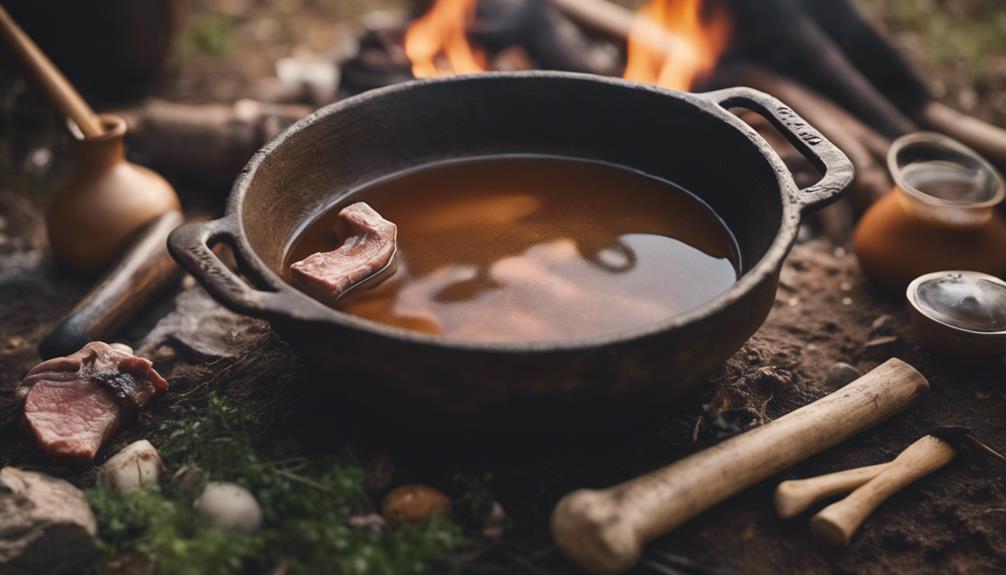
The historical roots of broth recipes can offer valuable insights into traditional culinary practices. Understanding the nutritional benefits of broth consumption in ancient times provides a foundation for exploring its relevance in today's diet.
Examining the evolution of modern broth variations sheds light on how this ancient elixir continues to adapt to contemporary tastes and dietary preferences.
Historical Broth Recipes
Amidst ancient culinary practices, the roots of broth-making can be traced back to civilizations that valued sustenance and nourishment for the body. Historical origins reveal that traditional practices of creating broth were prevalent in various cultures worldwide.
In ancient Egypt, bone broths were simmered over low heat to extract nutrients and flavor. Greek physicians recommended the consumption of broth for its healing properties. Chinese medicine utilized broth as a foundational element for health and wellness. The Romans crafted hearty broths using meats, vegetables, and herbs.
Across history, broth recipes evolved, incorporating regional ingredients and techniques. These ancient recipes laid the foundation for the diverse range of broths enjoyed today, each with a unique cultural and historical significance.
Nutritional Benefits Today
Exploring the nutritional benefits of broth today reveals a deep connection to its ancient origins across various cultures. Concerning health benefits, bone broth is a rich source of minerals such as calcium, magnesium, and phosphorus, which are essential for bone health. The slow cooking process in preparing broth helps to extract important nutrients like collagen and gelatin, which support gut health and improve skin elasticity. Additionally, the amino acids present in bone broth can aid in reducing inflammation and supporting the immune system.
From a culinary perspective, the versatile flavor profiles of broth make it a valuable ingredient for soups, stews, sauces, and even braising liquids. Understanding the nutritional benefits of broth today highlights its significance in both traditional and modern cooking practices.
Modern Broth Variations
As we move forward into discussing Modern Broth Variations, it's evident that the evolution of bone broth from its ancient origins has sparked innovative culinary adaptations and creative reinterpretations in contemporary cooking practices.
In recent years, chefs and home cooks alike have been experimenting with new ways to enhance the traditional bone broth recipe. One of the most notable trends is the use of flavorful seasonings such as herbs, spices, and aromatic vegetables to add depth and complexity to the broth's taste profile.
Additionally, culinary trends have seen the incorporation of exotic ingredients like lemongrass, ginger, and star anise, providing a unique twist to this time-honored dish. These innovative variations reflect a modern approach to bone broth preparation, catering to the evolving tastes of today's discerning consumers.
Essential Bone-Broth Components
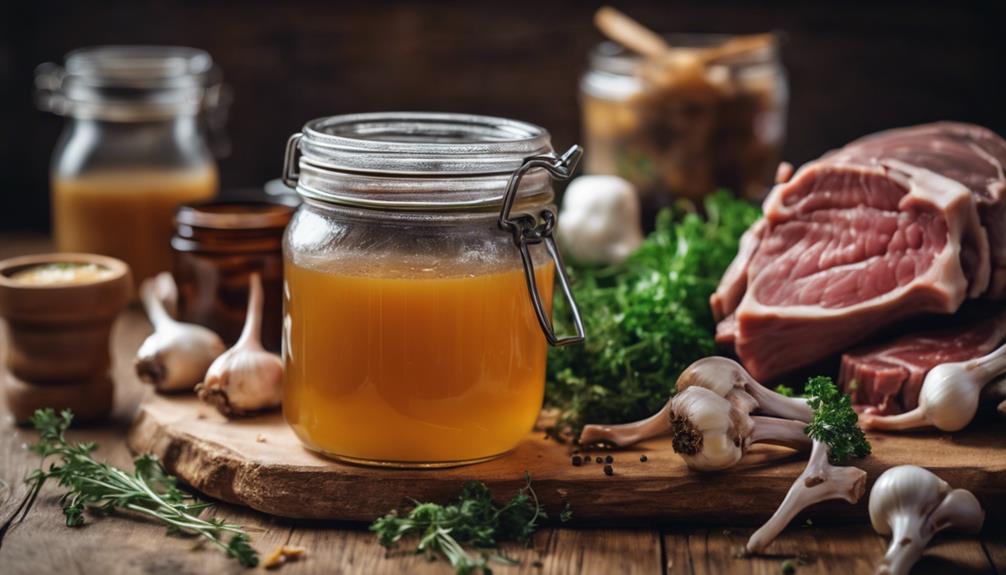
A perfect bone broth requires the precise combination of key components to achieve the desired flavor and nutritional profile. To create a rich and flavorful bone broth, consider the following essential components:
- High-Quality Bones: Start with grass-fed beef bones or pasture-raised poultry bones to guarantee a nutrient-dense base for your broth.
- Filtered Water: The quality of water used in the broth affects the overall taste and clarity. Opt for filtered water to prevent impurities.
- Flavorful Seasonings: Enhance the taste of your bone broth by adding aromatic herbs, spices like bay leaves, peppercorns, and even a touch of sea salt for depth.
- Rich Collagen: Collagen-rich bones like knuckles, feet, or joints are essential for achieving a gelatinous texture and extracting beneficial nutrients.
Broth Variations
Explore the diverse world of broth variations in the domain of sous vide cooking. From the rich and robust flavors of Beef Shank Bone Broth to the aromatic and soothing notes of a Ginger-Infused Broth Recipe, each variation offers a unique culinary experience.
Elevate your broth game with the tantalizing heat of a Spicy Lemongrass Broth Recipe, adding a kick of exotic spices to your sous vide repertoire.
Beef Shank Bone Broth
For enhancing the flavor profile of your beef bone broth, contemplate utilizing beef shank bones as a primary ingredient. When utilizing beef shank bones in your broth, you aren't only adding depth but also benefiting from the rich bone marrow they contain.
Here are some key points to contemplate when making beef shank bone broth:
- Rich Flavor: Beef shank bones offer a robust flavor profile to your broth.
- Gelatinous Texture: Slow cooking beef shank bones helps release gelatin, providing a velvety mouthfeel.
- Nutrient-Rich: The bone marrow in beef shank bones adds essential nutrients to your broth.
- Enhanced Aroma: Slow cooking allows the flavors to meld together, resulting in a fragrant broth.
Ginger-Infused Broth Recipe
Infusing your broth with ginger adds a subtle yet invigorating flavor dimension, elevating the taste profile with its aromatic and therapeutic qualities. Ginger not only enhances the broth's taste but also brings with it a host of health benefits. Here are some reasons why incorporating ginger into your broth is a great idea:
- Anti-Inflammatory Properties: Ginger is known for its anti-inflammatory effects, which can help reduce inflammation in the body.
- Digestive Aid: Ginger can aid digestion by helping to alleviate symptoms like bloating and indigestion.
- Immune-Boosting: The immune-boosting properties of ginger can help ward off common colds and illnesses.
- Antioxidant Rich: Ginger is rich in antioxidants, which can help combat oxidative stress in the body.
Spicy Lemongrass Broth Recipe
Consider incorporating lemongrass and chili peppers to create a vibrant and aromatic Spicy Lemongrass Broth that tantalizes the taste buds and adds a kick to your culinary creations. Lemongrass not only imparts a unique citrusy aroma but also offers various health benefits, including digestion aid and anti-inflammatory properties. When combined with spicy peppers, the broth reaches new levels of flavor complexity, making it a versatile base for a wide range of dishes.
Here are key elements to include in your Spicy Lemongrass Broth recipe:
- Lemongrass stalks for a citrusy punch
- Spicy chili peppers for a fiery kick
- Fresh ginger to enhance the depth of flavors
- Rich beef bones for a hearty foundation
Broth Clarifying Techniques
When clarifying your beef bone broth, you can employ several techniques to achieve a clear and vibrant final product. Skimming the broth regularly during the cooking process helps remove impurities and excess fat, enhancing clarity.
The egg white method involves adding whipped egg whites to the broth, which then bind with particles, making them easier to remove.
Lastly, cooling the broth allows sediment to settle at the bottom, making it simpler to separate from the clarified liquid.
Skimming for Clarity
For a clearer broth, skim the surface regularly to remove impurities and excess fat. Skimming is a crucial step in the clarifying process of bone broth.
To employ the skimming technique effectively, use a ladle or a fine mesh skimmer to gently remove any foam, scum, or fat that rises to the top during the cooking process.
By skimming the surface consistently, you guarantee that the broth remains clear and free of unwanted particles. This practice not only enhances the visual appeal of the broth but also improves its flavor and overall quality.
Regular skimming allows you to maintain a clean and pure broth that's perfect for sipping or using as a base for various recipes.
Egg White Method
To further refine the clarity of your bone broth, the Egg White Method can be employed as a meticulous technique for achieving a pristine and transparent liquid. This method involves adding beaten egg whites to the simmering broth, which then attract impurities as they coagulate, resulting in a clearer final product. The process aids in protein extraction, infusing flavors deeply into the broth while promoting gelatin formation for a rich mouthfeel. Additionally, nutrient retention is optimized through the removal of unwanted particles. Below is a table summarizing the benefits of the Egg White Method:
| Benefits | Description |
|---|---|
| Protein extraction | Helps extract proteins for a richer broth. |
| Flavor infusion | Enhances the depth of flavors in the broth. |
| Gelatin formation | Promotes the formation of gelatin for texture. |
| Nutrient retention | Aids in retaining essential nutrients in the broth. |
Cooling for Sediment
Consider implementing a cooling process to facilitate sediment settling as part of your broth clarifying techniques. After the sous vide cooking is complete, allow the broth to cool gradually to room temperature.
This gradual cooling process aids in sediment removal by allowing the heavier particles to sink to the bottom of the container. Once the broth has cooled, carefully transfer it to the refrigerator and let it chill for several hours or overnight.
During this cooling period, the remaining impurities and sediments will continue to settle, making it easier to skim them off the surface. By incorporating this cooling step into your broth preparation, you can achieve a clearer and more refined final product, free from unwanted particles.
Final Thoughts
In conclusion, the nutritional benefits of sous vide beef bone broth make it a valuable addition to a balanced diet. Reflections on the process reveal that the controlled temperature of sous vide cooking helps extract maximum nutrients and collagen from the bones, resulting in a nutrient-dense and protein-rich broth. The long cooking times at precise temperatures break down the bones and connective tissues, releasing amino acids, minerals, and other essential nutrients that support gut health, joint function, and skin elasticity.
In terms of taste and texture, the sous vide method guarantees a clear and flavorful broth with a rich mouthfeel. The extended cooking time allows for a deep infusion of flavors while maintaining a smooth and velvety texture. The collagen extracted during the process gives the broth a satisfying body and a silky finish, making it not only nutritious but also a delicious addition to various dishes. Incorporating sous vide beef bone broth into your diet can elevate your culinary experience while providing numerous health benefits.
Frequently Asked Questions
Can Bone Broth Help Improve Joint Health?
Improving joint health involves promoting joint mobility and cartilage repair. Bone broth, rich in collagen and amino acids, may support these processes. Regular consumption and a balanced diet can aid in maintaining healthy joints.
What Are the Best Bones to Use for Beef Bone Broth?
When making beef bone broth, opt for marrow bones and knuckle bones. These choices provide a rich source of nutrients for extraction during slow cooking. The combination of marrow and knuckle bones enhances flavor and nutritional content.
Does Sous Vide Cooking Affect the Nutritional Value of Bone Broth?
When cooking bone broth using sous vide, temperature control is essential for nutrient preservation. This method retains more nutrients compared to traditional cooking methods. Sous vide's gentle and consistent heat helps maintain the nutritional value of the broth.
Can Bone Broth Help With Digestive Issues?
Bone broth, known for gut healing properties, aids in reducing inflammation. Its rich collagen content benefits digestive issues. Incorporating bone broth into your diet may promote a healthier gut and alleviate discomfort from inflammation.
How Long Can Beef Bone Broth Be Stored in the Refrigerator?
Beef bone broth can be stored in the refrigerator for about 3-4 days. To guarantee freshness and safety, always check for signs of spoilage before consuming. Proper storage is key to maintaining the shelf life of bone broth.
Conclusion
To sum up, sous vide beef bone broth provides essential nutrients and benefits for the carnivore diet. With its ancient origins and various clarifying techniques, this broth serves as a valuable component in a well-rounded dietary regimen.
By understanding the key components and variations of bone broth, individuals can optimize their consumption to reap the full benefits of this nutrient-dense elixir. Incorporating sous vide techniques into the preparation process guarantees a consistent, high-quality broth that's both delicious and nourishing.







